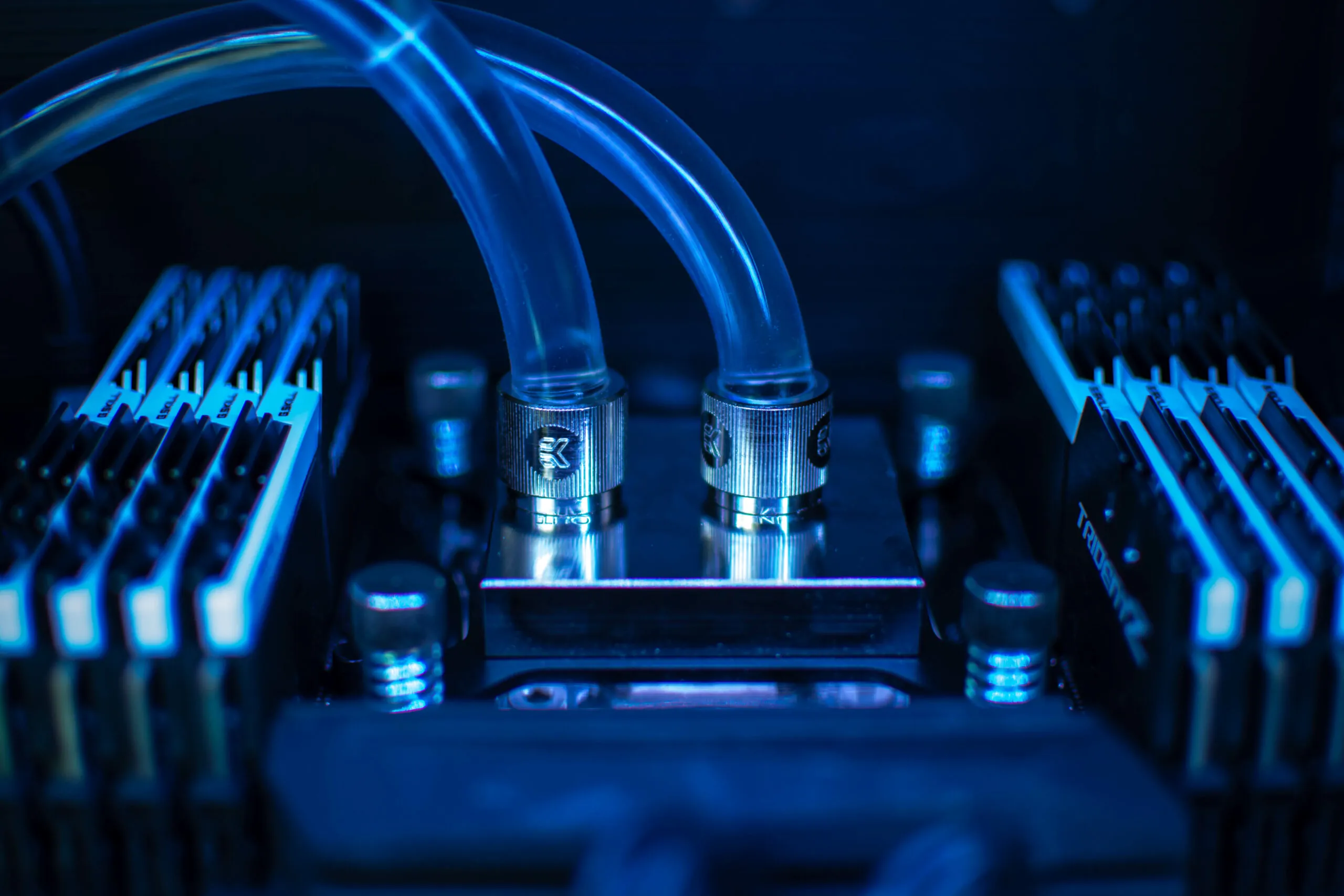Liquid Cooling Strategies: Meeting the AI Demand in Data Centers18 min read

Traditional techniques for cooling IT infrastructure like fans and A/C may not be enough to deal with the heat generated by the high-performance AI hardware available today. While rack density continues to average only a few kW per rack, specialized use cases are emerging that demand 30 or more kW. Thus, the industry is looking at liquid cooling as a solution.
According to Gartner, “Liquid cooling uses a liquid, such as water, or a refrigerant, rather than air, to cool the data canter. This allows the cooling solution to be brought closer to the heat source, thus requiring less, if any, fan power. Liquid cooling can solve the high-density, server-cooling problem, because liquid (conductive cooling) conducts more than 3,000 times as much heat as air and requires less energy to do so, allowing increased data center densities. Newer piping technology means the probability of leaks is extremely low.”
Unfortunately, the infrastructure required to bring liquid cooling into data centers can be complex, often making deployments slow, complicated, and pricey. As a result, access to liquid cooling tech has been limited to the likes of research and government labs operating supercomputers, and niche providers for AI and HPC (including hyperscalers and large colos). That may be about to change.
Leasing of Liquid Cooling
The AI boom has meant that more businesses, in more markets and in more industries, need access to liquid cooling technology than ever before. Accordingly, some of the big colos have formulated business plans to accommodate these workloads. Equinix, for example, is expanding support for liquid cooling technology to more than 100 data centers in 45 of its biggest metros. The goal is to bring liquid cooling technology closer to those enterprises running or planning to run compute-intensive workloads like AI.
“We have seen an increase in demand for data-intensive and high-compute applications like AI,” said Sean Graham, Research Director, Cloud to Edge Datacenter Trends at IDC. “The hardware required to run these new applications is pushing up densities inside data centers and can no longer be efficiently cooled by traditional techniques. We are seeing a growing demand for liquid-cooled solutions from enterprises, and it is essential that data center providers, like Equinix, can support this next generation of cooling solutions.”
Equinix already offers direct-to-chip liquid cooling in more than 45 metros—including London, Silicon Valley, Singapore, and Washington D.C. Direct-to-chip (DTC) involves a cold plate sitting on top of the chip inside the server. The cold plate is enabled with liquid supply and return channels, allowing technical cooling fluid to run through the plate, drawing heat away from the chip. This allows DTC-enabled servers to be installed in a standard IT cabinet like traditional air-cooled equipment. DTC can be single phase or two-phase, depending on whether or not the cooling fluid changes phase during the heat removal process.
DTC liquid cooling requires interior augmentation of the IT equipment and minor changes to the server exterior. It can be installed in a standard IT cabinet.
Bill Estes, GM of Anderson Power said this is similar to a model that succeeded in the telecom industry. “In parallel to how large telecom providers like Verizon lease spaces within their infrastructure to smaller players, this approach offers an efficient way for companies to access processing power on a smaller scale without the hefty capital investment,” he said. “Subleasing from established providers becomes a practical strategy, mirroring the telecom industry’s success, enabling broader access to advanced AI-based infrastructure without the necessity for individual data centers to build their own.”
Rear Door Cooling
In addition, Equinix has been rolling out rear-door heat exchangers (RDHe) in its data centers across the world. They use a cooling coil and fans to capture heat from air cooled IT equipment. They are mounted directly onto customer cabinets, so are able to manage higher cooling loads than conventional cooling.
Further, Equinix is partnering with vendors such as CoolIT Systems and ZutaCore to bring further cooling breakthroughs to a broader market. CoolIT offers such things as Coolant Distribution Units (CDU). RDHx, and Passive Coldplate Loops (PCLs).
“For next-generation chips and other AI infrastructure, traditional air-cooling approaches will not get the job done on their own,” said Steve Walton, CEO, CoolIT Systems. “Liquid-cooling can offer better performance while saving energy and helping data centers operate more efficiently.”
ZutaCore has been deploying two-phase immersion systems in some Equinix facilities. Single-phase cooling systems absorb heat via phase transformation, which refers to liquids’ ability to transform into vapor and condense back to liquid form. The Zutacore refrigerant turns to vapor at about 92℉ (33C). A small pool of fluid on top of a processor just needs topped up as it evaporates, thus cooling a metal plate in the chip’s casing.
LiquidStack is another company offering a variety of cooling solutions. This includes DLCs, CDUs, and single-phase cooling. The company believes that liquid cooling works in certain settings and that hybrid air and liquid cooling arrangements are likely to gain ground.
“There is no one liquid cooling solution that will fit every need or application, as data centers must factor in their location, workloads, sustainability goals, budget, and other considerations,” said Nick Schweissguth, Director of Product Management, LiquidStack. “Many data centers will be taking a hybrid air and liquid cooling approach for the foreseeable future.”
Real-time monitoring, data-driven optimization.
Immersive software, innovative sensors and expert thermal services to monitor, manage, and maximize the power and cooling infrastructure for critical data center environments.

Drew Robb
Writing and Editing Consultant and Contractor
Real-time monitoring, data-driven optimization.
Immersive software, innovative sensors and expert thermal services to monitor,
manage, and maximize the power and cooling infrastructure for critical
data center environments.
0 Comments